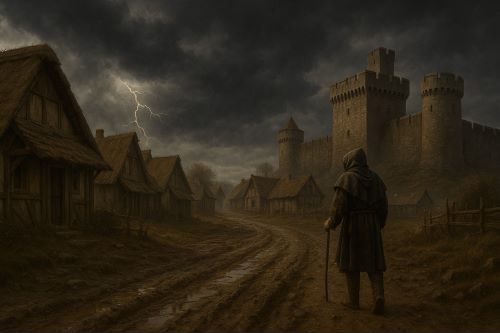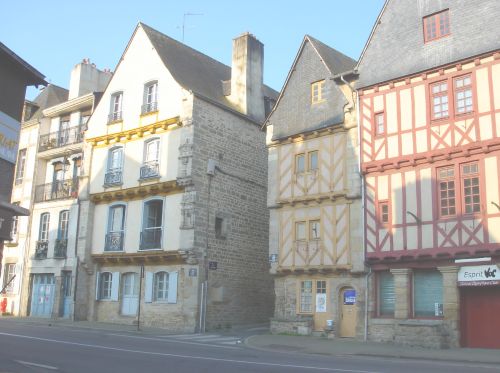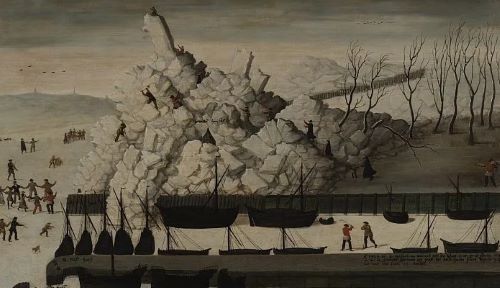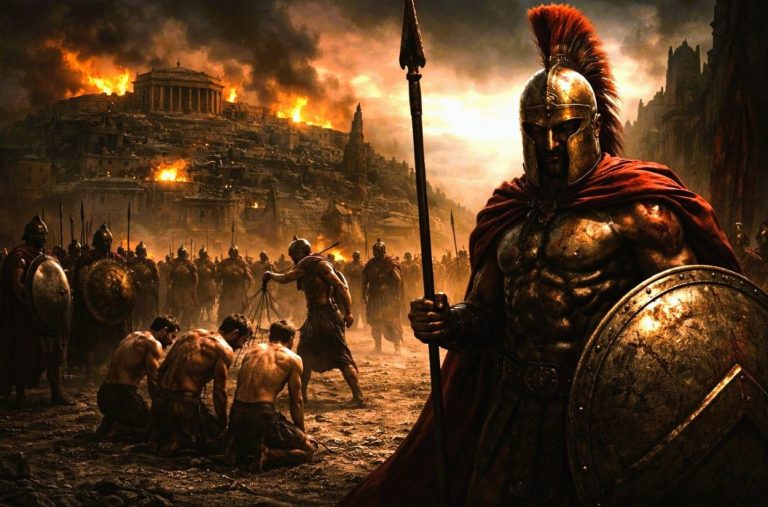

The Medieval Warm Period created space for expansion, but much of that expansion was borne by peasants who reaped little from its bounty.

By Matthew A. McIntosh
Public Historian
Brewminate
Introduction: Climate at the Margins of Power
The climate of the Middle Ages did not change in isolation. It transformed in tandem with the structures of labor, land, and loyalty that defined European society under feudalism. Weather, harvests, and famine were not mere acts of nature. They were acts filtered through a deeply stratified social order. A warming trend in the early medieval period brought population growth and agrarian expansion. Later, the onset of colder, wetter conditions introduced what historians now call the Little Ice Age. Yet neither climate phase was experienced evenly. Kings and clerics weathered the cold in stone halls and abbey stores. Peasants endured it in thatched cottages and empty fields.
Here I examine how climate shifts across the Medieval Warm Period and the Little Ice Age disproportionately affected the lower classes of medieval society. Through drought, deluge, and declining temperatures, the poor bore the weight of ecological upheaval. Meanwhile, landlords and institutions used their resources and authority not merely to survive but often to consolidate power in the wake of crisis. The story of medieval climate is thus a story of inequality written in grain prices and graveyards.
The Medieval Warm Period: Opportunity and Expansion for Some

From approximately 950 to 1250 CE, parts of Europe experienced what climatologists now term the Medieval Warm Period, a time of relatively mild and stable weather that allowed for agrarian expansion. Tree ring data, ice cores, and written records all suggest longer growing seasons and fewer harsh winters across much of northern and western Europe.1 For feudal lords and monarchs, this was an era of opportunity. Forests were cleared, wetlands drained, and uplands cultivated. Manorial estates grew in wealth as population expanded and surplus grain fed urban centers and ecclesiastical institutions.2
Yet this expansion was uneven in both its geography and its benefits. Much of the new agricultural land brought under the plow during this period was ecologically fragile, subject to erosion, or dependent on narrow climatic tolerances. The labor that fueled this transformation came from a class of serfs and tenant farmers who had little choice in the matter.3 Lords pushed peasants to cultivate higher-risk lands because it cost them nothing to do so. When those lands failed, it was the tenant who suffered. While grain flowed toward castles and monasteries, villages often survived on what they could scrape from declining yields.
The Church, too, benefitted from the warm period. As the largest landholder in Europe, it extracted tithes and rents even in marginal years. Monastic communities accumulated both surplus food and moral authority, framing weather patterns within a providential worldview.4 The faithful might pray for rain, but it was the landed Church that held the keys to the granary.
The Great Famine and the Limits of Adaptation

The end of the Medieval Warm Period did not arrive with sudden catastrophe, but its exit was marked by ominous signs. By the early 14th century, a pattern of cooler and wetter weather began to settle over much of Europe. From 1315 to 1322, a series of crop failures struck the continent, culminating in what historians now call the Great Famine. Chroniclers from England to France recorded incessant rain, rotting grain, and fields too sodden to plow.5
In such times, the inequality of adaptation became stark. Lords with granaries could hoard food or sell it at inflated prices. Cities imposed price controls and rationing. The poor, with no stores or bargaining power, starved. One estimate suggests that between ten and fifteen percent of the European population perished during these years.6 Entire villages disappeared from tax rolls. Chronic malnutrition left survivors vulnerable to disease, and rumors of cannibalism and infanticide emerged in the margins of medieval chronicles.7
Despite the massive human toll, the social order remained largely intact. The elite were shaken, but not displaced. Their estates may have suffered losses, but their wealth allowed them to weather the storm, often quite literally. It was the peasantry who paid, not only in lives, but in the tightening of feudal obligations as lords sought to recoup their losses through higher rents and stricter labor controls.
The Little Ice Age: From Crisis to Control

The cooling that began in the 14th century would stretch across centuries. Though the term “Little Ice Age” is something of a misnomer; there was no continental glaciation. The period from the 1300s to the 1800s was marked by lower average temperatures, erratic weather, and an increase in severe winters and crop-destroying storms.8
In this colder climate, the inequalities of feudal Europe became even more entrenched. Marginal lands reclaimed during the warm period were often abandoned. Highlands reverted to pasture. Settlements shrank. The agricultural system, already stretched thin by demographic pressures and uneven land distribution, buckled under the stress.
Yet the elite adapted with a grim efficiency. In England, the enclosure movement (the privatization of common lands) accelerated. In central Europe, serfdom hardened into a more exploitative system as lords demanded more labor to compensate for lower yields.9 The Church and nobility retained their legal privileges even as the conditions of life for the rural poor deteriorated. In many cases, landlords used the crisis to expand control. Famine was not simply endured. It was managed and, at times, monetized.
Climate did not invent inequality in the medieval world. But it amplified it. Each cold year became a test of power, and power consistently flowed upward.
Conclusion: Echoes of Uneven Exposure
The history of climate in the medieval world is not a history of natural disaster alone. It is a history of social exposure, of who suffers, who adapts, and who profits when the seasons turn against the land. The Medieval Warm Period created space for expansion, but much of that expansion was borne by peasants who reaped little from its bounty. The Little Ice Age brought crisis, and in that crisis the burdens again fell heaviest on those with the least. The elite adapted, not because they were more virtuous or industrious, but because they were insulated by wealth, by custom, and by a system designed to extract from those already at the edge.
Today, as we face our own climate crisis, the past reminds us that environmental change does not fall evenly. It falls along the lines of class, privilege, and geography. The medieval world offers no solutions. But it offers a warning — one that still waits to be heeded.
Appendix
Footnotes
- Hubert H. Lamb, Climate, History and the Modern World (London: Routledge, 1995), 153–158.
- Bruce M. S. Campbell, The Great Transition: Climate, Disease and Society in the Late-Medieval World (Cambridge: Cambridge University Press, 2016), 32–37.
- Rodney Hilton, Bond Men Made Free: Medieval Peasant Movements and the English Rising of 1381 (London: Routledge, 1973), 18.
- Barbara Rosenwein, A Short History of the Middle Ages (Toronto: University of Toronto Press, 2009), 142–145.
- William Chester Jordan, The Great Famine: Northern Europe in the Early Fourteenth Century (Princeton: Princeton University Press, 1996), 17–23.
- Ibid., 44.
- Jordan, The Great Famine, 86–90.
- Geoffrey Parker, Global Crisis: War, Climate Change and Catastrophe in the Seventeenth Century (New Haven: Yale University Press, 2013), 35–39.
- Emmanuel Le Roy Ladurie, Times of Feast, Times of Famine: A History of Climate Since the Year 1000 (Garden City: Doubleday, 1971), 207–213.
Bibliography
- Campbell, Bruce M. S. The Great Transition: Climate, Disease and Society in the Late-Medieval World. Cambridge: Cambridge University Press, 2016.
- Hilton, Rodney. Bond Men Made Free: Medieval Peasant Movements and the English Rising of 1381. London: Routledge, 1973.
- Jordan, William Chester. The Great Famine: Northern Europe in the Early Fourteenth Century. Princeton: Princeton University Press, 1996.
- Lamb, Hubert H. Climate, History and the Modern World. London: Routledge, 1995.
- Le Roy Ladurie, Emmanuel. Times of Feast, Times of Famine: A History of Climate Since the Year 1000. Garden City: Doubleday, 1971.
- Parker, Geoffrey. Global Crisis: War, Climate Change and Catastrophe in the Seventeenth Century. New Haven: Yale University Press, 2013.
- Rosenwein, Barbara. A Short History of the Middle Ages. Toronto: University of Toronto Press, 2009.
Originally published by Brewminate, 07.14.2025, under the terms of a Creative Commons Attribution-NonCommercial-NoDerivatives 4.0 International license.


